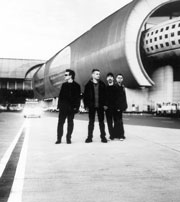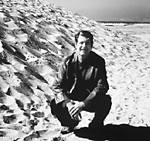I VOLUNTEERED TO write a biography of Bruce Springsteen because I saw him 25 years ago and I liked him. The two shows he did in London in November 1975 are legend: high-tension, scenic orgies that had the Brits stroking their collective stubble and writing headlines like “Re-mythologizing Americana.” They were pretty good gigs, too. I took to him because of his rather old-fashioned songs, his obvious sincerity, and his vulnerable, strained, but engaging look (he was wearing a hat the size of a throw cushion). I felt that if I’d met him in school, I would have wanted to make friends with him. He seemed at that time a serious working musician rather than the ritualized Boss to whom presidents would pay court.
Bruce Springsteen & the E Street Band
Tacoma Dome, Tuesday, April 4
When, six years later, I saw his great London comeback, he was not only plugging The River but was now a virtual jukebox of ’60s rock styles. The former seemed a mite jarring, but all of it felt suffused with a kind of melancholy. I also thought it beautifully ordered. The contradiction of frat-house pop and invocatory folk was strange and impressive in its way. Nebraska I thought masterly. I never joined the belief in his next album’s immortality, but Born in the USA had its moments, too. It only did 20 million copies.
I just mention this by way of context. I admire Bruce Springsteen. Reciprocally, I doubt that he particularly approves or disapproves of my book. I doubt that he even knows about it. Part of his manager Jon Landau’s legacy to rock is the Maginot Line of PR flacks and lawyers that nowadays shields every act. The music may be cannon-fired and raucous, but there’s nothing remotely free-form about the organization behind it. Interviewing Margaret Thatcher was a snap by comparison.
After several months’ doomed application, I realized I had a choice. I could wait the rest of my life to meet Hamlet, or I could move on to the supporting cast. Of those who did make time or comment available, I remember Lynn Goldsmith, Springsteen’s ex, describing the night he hauled her out of a pit at Madison Square Garden and twisted her arm so hard she “thought it would break.” The basic story involved three strands of source material. At the cutting edge were the musicians, an anonymous E Streeter and men like Keith Richards and Graham Parker and Mitch Ryder, who spoke about how Bruce, having escaped Dylan’s shadow, grew enough stylistically to cast his own. In the middle were the journalists, photographers, friends, fans, and neighbors who rightly praised Springsteen-the-guy. And either over or below them were the politicians who, in at least one case, tried to colonize him. I enjoyed an hour with Bill Bradley.
In all, I thought, a tolerable bit of improvisation and a straight enough read. Good, knockabout stuff. So there’s been much innocent fun to be gathered from watching the reviewers tease out their customary feeling of befuddlement and despair to fill the allotted wordage. Some linger over the sex (the British wanting more, the Americans less). Others flannel wildly or pad the piece with the frustrated biographies of their own. A choice few manage the transition from the embittered into that more exalted realm, the truly gormless. A doffed cap in this respect to the bard in the Springsteen Gazette who accuses me, witheringly, of having listened to all his hero’s music and read all the previous copy. Guilty as charged, Bob. It’s called secondary research.
Of course it’s always traumatic to see good work maligned by hacks, simply by virtue of their superior knowledge, exquisite taste, scholarship, freedom from self-righteousness, purity of heart, universal wisdom—particularly the last, in having an opinion about everything. I’m sure it’s happened to Bruce, too. Luckily, there can never be a hidden agenda whereby the hack is actually objecting to the artist personally, to his disinterest and even his success. Nor would private resentment ever be disguised in such cases as public service.
CHANGING THE SUBJECT completely, the Springsteen fanzine Backstreets began life in Seattle 20 years ago. Bruce himself has a long and sometimes checkered Northwest connection. At the Tacoma Dome in 1984 he deep-sixed “Rosalita” for the first time in 11 years, a song that presents the same sort of problem as “Layla”—everybody wants to hear it, but it needs a break. Springsteen controversially crossed a picket line to play the same venue in 1992. He’s always given generously to Northwest Harvest, a local food bank, whenever in the area.
As for the actual music . . . I remember Springsteen and the E Street Band’s reunion gig in London late last spring. It was a cold, raw night in Earls Court, a concrete bunker with the tang of a recent horse show still in the air. Even in this sorry dive, to an audience of suits clutching their briefcases, Bruce got the middle-aged Brits dancing in the dark. I don’t know how he did it, and I was there. I still am.
Christopher Sandford is the author of Springsteen Point Blank, available from De Capo Press.







